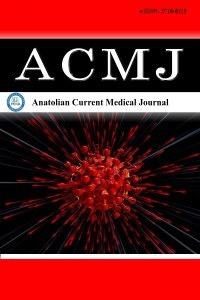A new grading system for evaluation of uroflowmetry-EMG results (Gülhane Grading System)
A new grading system for evaluation of uroflowmetry-EMG results (Gülhane Grading System)
___
- Wenke S, Van Batavia JP, Combs AJ, Glassberg KI. Analysis of uroflow patterns in children with dysfunctional voiding. J Pediatr Urol 2014; 10: 250-4.
- Norgaard JP, van Gool JD, Hjalmas K, Djurhuus JC, Hellstrom AL. Standardization and definitions in lower urinary tract dysfunction in children. International Children’s Continence Society. Br J Urol 1998; 81: 1-16.
- Neveus T, von Gontard A, Hoebeke P, et al. The standardization of terminology of lower urinary tract function in children and adolescents: report from the Standardisation Committee of the International Children’s Continence Society. J Urol 2006; 176: 314-24.
- Austin PF, Bauer SB, Bower W, et al. The standardization of terminology of lower urinary tract function in children and adolescents: update report from the Standardization Committee of the International Children’s Continence Society. J Urol 2014; 191: 1863-5.
- Chase J, Austin P, Hoebeke P, McKenna P. The management of dysfunctional voiding in children: a report from the Standardisation Committee of the International Children’s Continence Society. J Urol 2010; 183: 1296-302.
- Austin PF, Bauer SB, Bower W, et al. The standardization of terminology of lower urinary tract function in children and adolescents: Update report from the standardization committee of the International Children’s Continence Society Neurourol Urodyn 2016; 35: 471-81.
- Kajbafzadeh AM, Yazdi CA, Rouhi O, Tajik P, Mohseni P. Uroflowmetry nomogram in Iranian children aged 7 to 14 years. BMC Urol 2005; 16: 5-3.
- Gupta DK, Sankhwar SN, Goel A. Uroflowmetry nomograms for healthy children 5 to 15 years old. J Urol 2013; 190: 1008-13.
- Combs AJ, Grafstein N, Horowitz M, Glassberg KI. Primary bladder neck dysfunction in children and adolescents I: pelvic floor electromyography lag time--a new noninvasive method to screen for and monitor therapeutic response. J Urol 2005; 173: 207-10
- Akbal C, Genc Y, Burgu B, Ozden E, Tekgul S. Dysfunctional voiding and incontinence scoring system: quantitative evaluation of incontinence symptoms in pediatric population. J Urol 2005; 173: 969-73.
- Koff SA. Estimating bladder capacity in children. Urology 1983; 21: 248.
- Samijn B, Van Laecke E, Vande Walle J, et al. Uroflw measurement combined with electromyography testing of the pelvic floor in healthy children. Neurourol Urodid 2019; 38: 231-8.
- Kılıç A, Hacıhamdioğlu DÖ, Tural E, Karademir F. Evaluation of neuropsychological development of children diagnosed with primary monosymptomatic nocturnal enuresis: A pilot study. Turk J Urol 2020; 46: 320-5
- Ferrara P, Franceschini G, Mercurio S, Del Vescovo E, Ianniello F, Petitti T. The adverse effects of oral desmopressin lyophilisate (MELT): personal experience on enuretic children. Turk J Urol 2018; 44: 51-5.
- Abrams P, Cardoso L, Fall M, et al. The standardization of terminology in lower urinary tract function: report from the standardisation subcommittee of the International Continence Society. Urology 2003; 61: 37-49
- Sinha S. Dysfunctional voiding: A review of the terminology, presentation, evaluation and management in children and adults. Indian J Urol 2011; 27: 437-47.
- Wenske S, Combs AJ, Van Batavia JP, et al. Can staccato and interrupted/fractionated uroflow patterns alone correctly identify the underlying lower urinary tract condition? J Urol 2012; 187: 2188-93.
- Sharifi-Rad L, Seyedian SL, Fatemi-Behbahani SM, Lotfi B, Kajbafzadeh A. Impact of transcutaneous interferential electrical stimulation for management of primary bladder neck dysfunction in children J Pediatr Urol 2020; 16: 36.
- Corcos J, Schick E. Prevelence of overactive bladder and incontinence in Canada. Can J Urol 2004; 11: 2278-84.
- Ergin G, Kibar Y, Ebiloğlu T, et al. The role of urinary nerve growth factor for the diagnosis and assessment of the biofeedback success in children with dysfunctional voiding. J Pediatr Urol 2016; 12: 118.
- Yayın Aralığı: 6
- Başlangıç: 2019
- Yayıncı: MediHealth Academy Yayıncılık
Muharrem BAYRAK, Kenan ÇADIRCI
Thromboprophylaxis decreases the risk of pulmonary embolism in COVID-19
Murat UĞUR, Taha Yusuf KUZAN, Nurettin YİYİT
Comparison of lesion level and ischemic modified albumin in peripheral artery disease
Cihan YÜCEL, Serkan KETENCİLER, Aslıhan TENEKECİGİL, Hüseyin GEMALMAZ, Sevgi ÖZCAN, Nihan KAYALAR
The level of C-erbB-2 in patients with esophageal and gastric cancers
Serkan CERRAH, Salim Başol TEKİN
Tigecycline induced acute pancreatitis: Suspicion is the first step in diagnosis
Alpaslan TANOĞLU, Eylem ÇAĞILTAY
A new grading system for evaluation of uroflowmetry-EMG results (Gülhane Grading System)
Burak KÖPRÜ, Giray ERGİN, Turgay EBİLOĞLU, Bahadır TOPUZ
A rare case: acute ischemic stroke that developed in a case with severe COVID-19 pneumonia
Özlem ERTAN, Esma Sevil AKKURT, Tuğçe ŞAHİN ÖZDEMİREL, Berna AKINCI ÖZYÜREK
